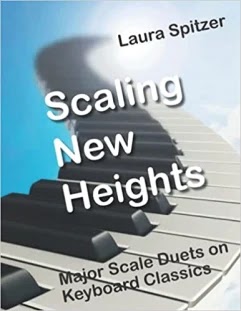Over the past year of social isolation, teaching via Zoom, I and some of my students have gotten a lot of enjoyment playing saxophone transcriptions of the six Bach Cello Suites. We've been using Six Suites for Violoncello Solo, transcribed and edited by Trent Kynaston (Advance Music, 1995). The music is perfect for our present situation - Bach wrote the Suites for unaccompanied cello; the pieces are self-contained, with harmony and counterpoint embedded in the melodic lines. The music is uplifting and satisfying in its beauty and logical perfection.
As teaching material, it's very effective. In normal times, I use duets quite a bit in teaching. It's not possible to play duets on Zoom, due to lag, but the unaccompanied Bach pieces can be taught through demonstration, and don't need any accompaniment to sound complete. In Kynaston's transcriptions, the pieces mostly sit well on the saxophone, and are just challenging enough for an advanced high school player.
Saxophonists are at a bit of a disadvantage when it comes to classical repertoire. Because the instrument was invented in the 1840s, it wasn't in existence for Bach, Haydn, Mozart, or Beethoven. Even through the 1800s, it was slow to be accepted in the world of classical music. If I want to familiarize students with classical "common practice" music, I've used pieces like the Ferling etudes (originally for oboe), or Kuhlau flute duets (playable on saxophone). Kynaston's Bach transcriptions have really filled a need. I can recommend them to teachers, as well as to saxophonists who would enjoy hearing Bach "from the inside," so to speak.
The book is not entirely error-free. One note puzzled me enough that I did some internet research, looking for an original manuscript, to check that note. In his preface, Kynaston states that his edition, as well as all others since 1825, is based on a manuscript "in Bach's own hand, held in the Prussian State Library in Berlin." He states that the manuscript showed no articulation marks, and that he had added articulations that are stylistically appropriate, and effective for saxophone. He advises readers to feel free to change them, if we prefer. For the most part, I like his articulations as printed.
The question of original sources led me to jsbachcellosuites.com, a great website that, among other things, displays facsimiles of the four most definitive extant manuscripts of the Cello Suites. One was copied by Anna Magdalena Bach (Johann Sebastian's second wife), another by Johann Peter Kellner. Both of these copies were created in J. S. Bach's lifetime. The other two manuscripts were created somewhat later, by persons unknown. There is no known existing manuscript by J. S. Bach himself. Kynaston was undoubtedly referring to the version by Anna Magdalena. This version has served as the basis for most (but not all) of the editions printed in the last two centuries. Kynaston was not the only editor over the years to have mistakenly assumed that Anna Magdalena's version was in J. S. Bach's hand.
Anna Magdalena's version does in fact show slurs, which may represent bowing indications, rather than slurs as wind instrument players understand them. But still, bowing decisions do result in certain phrasing. Articulation and phrasing are intertwined concepts. Unfortunately, the exact placement of her slur marks is often unclear. The slur markings in this source might not actually have been so useful for a sax edition.
Digging a little deeper, I ran across a 2016 doctoral thesis by Zoltán Szabó. It's an extensive exploration of the sources for the Cello Suites, as well as many of the editions that have been printed between 1824 and 2016. If you're interested in some state-of-the-art scholarship on this subject, it's great reading.
Szabó makes a strong case that although we have no definitive source for Bach's exact intentions, the manuscript by Kellner may be the closest that we have, as it may have been copied from an original manuscript that J. S. Bach created at a later date than the version that was copied by Anna Magdalena. Szabó discusses articulations, but does not treat that subject extensively; he considers it beyond the scope of his thesis, which already runs to 272 pages.
Even if we allow that Anna Magdalena's slur markings might be helpful in deciding on appropriate articulations, the extant sources and the various printed versions are nowhere close to agreeing. Below is a page from Szabó's thesis, comparing markings for just one measure, as shown in various sources and editions. Source A is Anna Magdalena; source B is Kellner; sources C and D are the other 18th-century manuscripts; source E is the first printed edition (perhaps based on a different, lost early manuscript).
All the examples are marked differently:
Although the question of appropriate articulations for the Suites has been the subject of endless scholarly discussion, it seems that in the end, players have to consider different printed and recorded sources, and make their own decisions.
The Kynaston edition can be purchased from Amazon through
this link. The Cello Suites have also been transcribed for other instruments, including guitar, mandolin, viola, violin, horn, double bass, clarinet, flute, tenor banjo, trombone, and organ.






